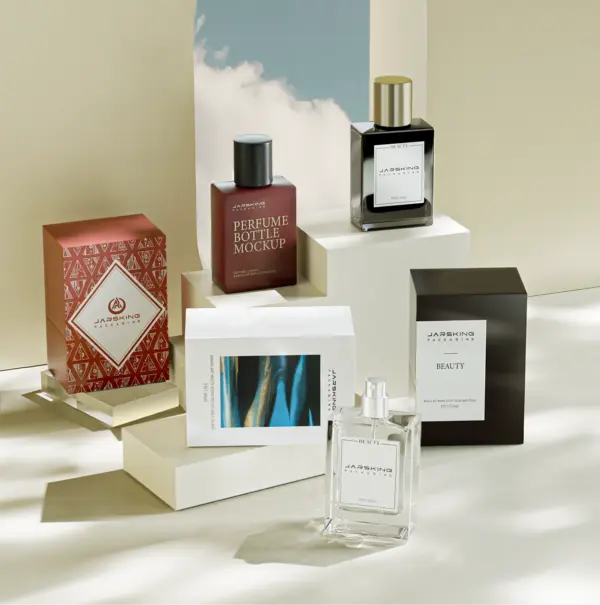Fragrance is more than just a finishing touch to one’s outfit—it is an invisible accessory, a personal signature, and sometimes even a memory bottled. Perfumes and colognes have been part of human culture for thousands of years, with roots stretching back to ancient Mesopotamia and Egypt. Civilizations across history have used fragrant oils, resins, and incense not only for beauty but also for rituals, worship, and healing. Today, fragrance has become a global industry and a form of self-expression that transcends cultures and generations.
Yet, for all its popularity, one aspect of perfume still confuses many: concentration. If you have ever purchased a fragrance, you have likely seen terms like eau de toilette, eau de parfum, or parfum listed on bottles. These are not just fancy marketing terms—they indicate the concentration of aromatic compounds in the formula. Put simply, they reveal how strong, long-lasting, or subtle a fragrance will be.
But here’s where it gets tricky: a higher concentration doesn’t always mean a stronger smell, a louder projection, or a better-quality perfume. In fact, the relationship between concentration and the fragrance experience is far more nuanced. Understanding concentration allows you to choose scents that truly match your preferences, lifestyle, and even budget.
This blog will demystify fragrance concentrations. We’ll break down the industry’s main categories, explain how concentration impacts longevity and performance, explore how external factors like climate and skin type influence your experience, and debunk common myths that often mislead fragrance lovers. Whether you are new to perfumes or looking to refine your collection, this deep dive will help you appreciate the craftsmanship behind fragrance and make more confident buying decisions.
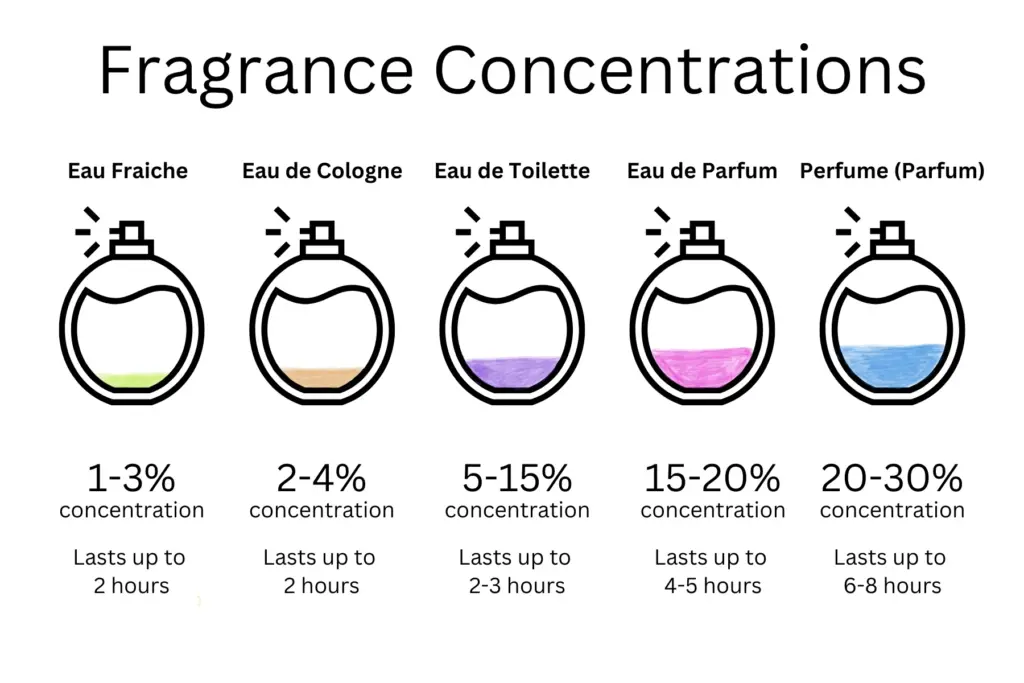
Basics of Fragrance Concentration
Before diving into the different categories, it’s important to understand what fragrance concentration really means. At its core, fragrance is a mixture of essential oils, aroma chemicals, fixatives, alcohol, and water. The ratio of oils to solvent is what determines a fragrance’s concentration.
Definition of Concentration
- Fragrance concentration refers to the percentage of perfume oils in the total mixture.
- For example, a fragrance with 20% oils in an alcohol or water base will generally be richer and longer-lasting than one with only 5%.
The oils are where the aroma lives. Alcohol and water are essentially carriers that help disperse the scent when sprayed and evaporate over time, releasing the fragrance notes.
General Ranges of Perfume Oils
- Low concentrations (1–5%): Very light, subtle scents. Typically found in splashes, aftershaves, or body mists.
- Medium concentrations (5–20%): The most widely used, offering balance between strength, duration, and price.
- High concentrations (20–30%+): Rich, luxurious, and often designed for special occasions; expensive but long-lasting.
Factors Affecting Performance
Even with these percentages, it’s not as black-and-white as the numbers might suggest. Several factors influence how a perfume performs:
- Skin chemistry: Oily vs. dry skin changes how well a fragrance “sticks.”
- Application method: Spraying vs. dabbing alters projection.
- Climate: Hot weather amplifies diffusion, while cold dampens it.
- Storage: Light and heat can break down perfume oils, weakening longevity.
Why Concentration Impacts Price
Generally, higher concentrations mean more perfume oil, and thus, greater cost. However, marketing, rarity of raw materials, and brand positioning also contribute to price differences. A niche Eau de Toilette might be more expensive than a mass-market Eau de Parfum simply because the ingredients are rarer or more artisanal.
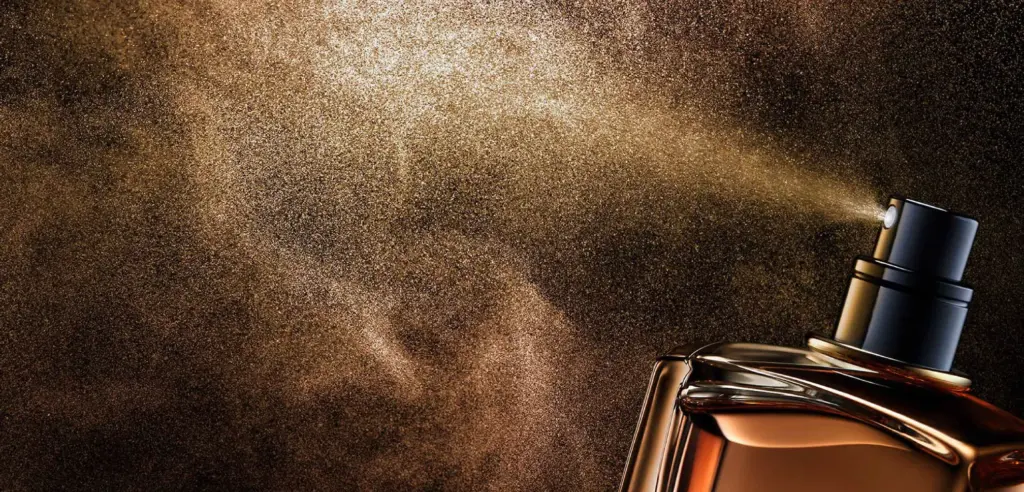
The Different Fragrance Categories
Fragrance houses across the world categorize their creations according to concentration levels, which in turn influence how strong, long-lasting, and noticeable a scent will be. But each category has its own unique role in perfumery history and its own set of advantages and limitations. Below, we’ll take a deep dive into each major type—from the whisper of Eau Fraîche to the regal depth of Extrait de Parfum.
Eau Fraîche (1–3%)
Overview:
Eau Fraîche, meaning “fresh water” in French, sits at the very bottom of the concentration scale. With just 1–3% perfume oils dissolved mostly in water, it offers the lightest and most fleeting expression of fragrance. Often more refreshing than perfuming, it borders on being more of a cosmetic splash than a traditional perfume.
Longevity and Projection:
- Typically lasts 30 minutes to 2 hours maximum.
- Projects very little beyond the skin—sometimes noticeable only to the wearer.
Use Cases:
- Ideal for hot climates. Eau Fraîche is perfect in tropical or humid weather, where intense fragrances can become overwhelming. Imagine sipping a cool mineral water on a blazing summer day; Eau Fraîche functions the same way for your senses—clean, refreshing, and delicate.
- Work-safe or allergy-friendly. For individuals who find perfume overbearing or work in heavily fragrance-sensitive spaces (like healthcare or education), Eau Fraîche provides a subtle option without being intrusive.
- Quick fresh-up. After a workout, during travel, or before heading to a casual lunch, a splash of Eau Fraîche delivers a fast burst of freshness.
Typical Ingredients & Style:
Fitting its name, Eau Fraîche compositions often emphasize citrus accords like lemon, bergamot, grapefruit, or light floral touches like orange blossom. These top notes are volatile and evaporate quickly, aligning perfectly with this concentration’s fleeting character.
Examples in the Market:
Many designer brands release “Eau Fraîche” editions of popular perfumes in summer. These variations play up freshness by dialing down density. For example, a woody-spicy fragrance might be reformulated into a breezy Eau Fraîche edition by focusing on citrus, aquatic, or herbal notes.
Eau de Cologne (2–5%)
Overview:
Though in modern English “cologne” often means “men’s fragrance,” in perfumery it has a more specific meaning. Eau de Cologne originates from Cologne, Germany, in the early 18th century, where Italian perfumer Giovanni Maria Farina created the first “Cologne Water,” a blend rich in citrus, rosemary, and neroli. This refreshing formula became wildly popular across Europe.
True Eau de Cologne is typically 2–5% perfume oils mixed with a substantial amount of alcohol. Unlike Eau Fraîche, colognes are slightly stronger, often lasting up to 2–3 hours. Their identity is rooted in lightness, vibrancy, and refreshment.
Longevity and Projection:
- Stays noticeable for 1–3 hours, depending on climate and application.
- Projection is modest, creating a clean “aura” rather than a room-filling trail.
Use Cases:
- Morning routines. In the 19th and early 20th centuries, Eau de Cologne was considered part of daily hygiene, like brushing teeth. Wealthy Europeans would apply liberal splashes of Cologne each morning as both fragrance and mild antiseptic.
- Refreshing pick-me-up. Its sparkling citrus makes it perfect for post-shower application or as an early afternoon recharge.
- Cultural staple in men’s grooming. Many aftershaves and barbershop products are Cologne strength because of their fleeting, uplifting quality.
Style & Ingredients:
Colognes are almost always citrus-forward: bergamot, lemon, mandarin, and petitgrain. Herbal touches like rosemary or lavender add an aromatic kick, while light floral or musky bases provide balance. They are intentionally short-lived by design, delivering zest without commitment.
Examples in the Market:
- 4711 Original Eau de Cologne — The archetypal Cologne water, still in production today since 1792.
- Acqua di Parma Colonia — A luxurious Italian reinterpretation that has stood as an icon of sophistication since 1916.
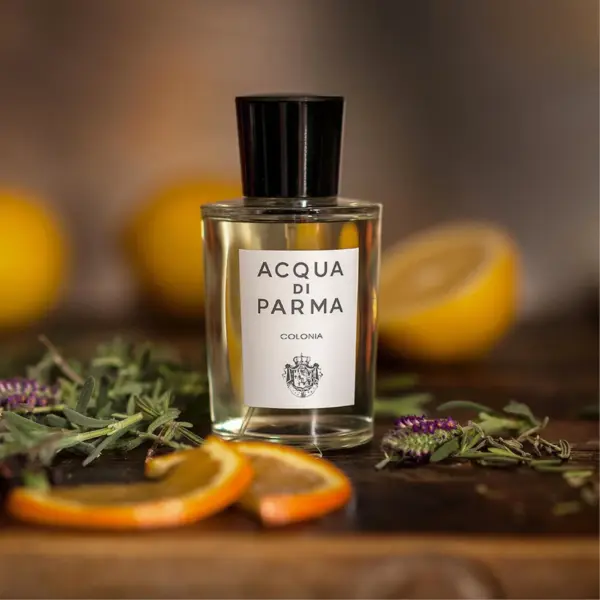
Eau de Toilette (EDT, 5–15%)
Overview:
Sitting squarely in the middle of concentration levels, Eau de Toilettes are the most widespread and commercially successful category. Containing 5–15% perfume oils, they typically last 3–6 hours. Their balance of affordability and performance makes them the default format for countless fragrances worldwide.
The name “toilette” comes from the French phrase faire sa toilette, meaning one’s personal grooming ritual. In this context, “toilette water” was simply a lighter version of perfume to accompany daily routines.
Longevity and Projection:
- 3–6 hours longevity (higher end for denser notes like woods, musks, or orientals; lower end for citrus).
- Projection is moderate—capable of being noticed without overwhelming.
Use Cases:
- Perfect for daily wear. Eau de Toilette is light enough for work and casual environments yet noticeable enough to convey style.
- Adaptable for layering. You can pair them with matching lotions, aftershaves, or colognes for more depth.
- Budget-friendly option. Because EDTs require less pure oil, they’re frequently offered at accessible price points.
Style & Ingredients:
Eau de Toilettes can encompass any olfactory family: from crisp aquatics to flowery bouquets to spiced leathers. Many designers release EDT as the first entry to the market, followed later by Eau de Parfum versions for those desiring more depth.
Examples in the Market:
- Chanel Bleu de Chanel (EDT) — One of the most popular modern men’s fragrances, praised for its fresh yet woody balance.
- Dior Sauvage EDT — A global best-seller with powerful projection despite being “only” an EDT.
- Dolce & Gabbana Light Blue (EDT) — Quintessential Mediterranean freshness for summer wear.
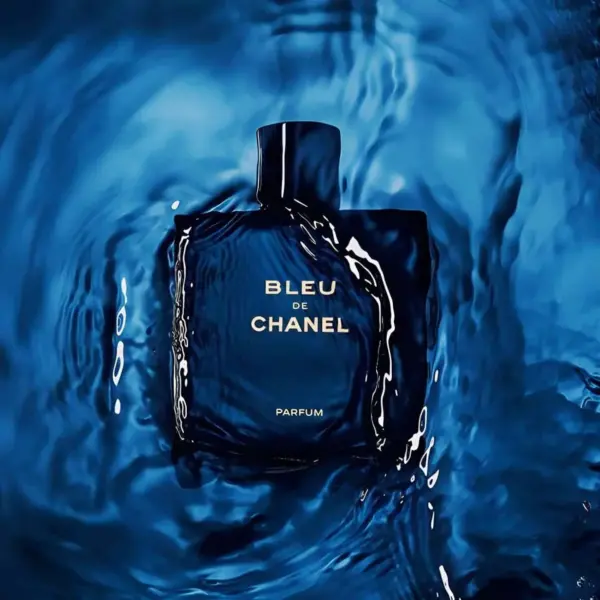
Eau de Parfum (EDP, 15–20%)
Overview:
Currently the most favored category across both designer and niche perfume houses, Eau de Parfum strikes the ultimate sweet spot between richness and wearability. Containing 15–20% oils, Eau de Parfum formulations typically deliver 6–10 hours of longevity, with strong presence and evolution.
Longevity and Projection:
- Longevity: 6–10 hours (sometimes longer on fabric).
- Projection: Moderate to strong, particularly in the first few hours before settling closer to skin.
Use Cases:
- Day-to-night versatility. Suitable for everything from office wear to dinner outings.
- Signature scent lovers. For someone seeking a single fragrance to wear year-round, EDP is reliable and noticeable.
- Cold-weather resilience. Thicker oils in EDP diffuse well in cooler temperatures, making them great companions in autumn or winter.
Cultural Trend:
In the last two decades, Eau de Parfum has risen dramatically in prominence. Many brands now release the EDP before the EDT version (opposite of tradition) because consumers equate EDP with higher quality or stronger value.
Style & Ingredients:
EDPs can better express complex note structures, letting heart and base notes (amber, woods, spices, florals) shine. Fragrances in this category often feel more complete or “rounded” compared to their EDT siblings.
Examples in the Market:
- Yves Saint Laurent Black Opium (EDP) — A modern Oriental gourmand beloved for its coffee and vanilla notes.
- Maison Francis Kurkdjian Baccarat Rouge 540 (EDP) — A niche fragrance that redefined modern luxury with its ambroxan-driven projection.
- Chanel Coco Mademoiselle (EDP) — Iconic balance of citrus, rose, patchouli, and musk.
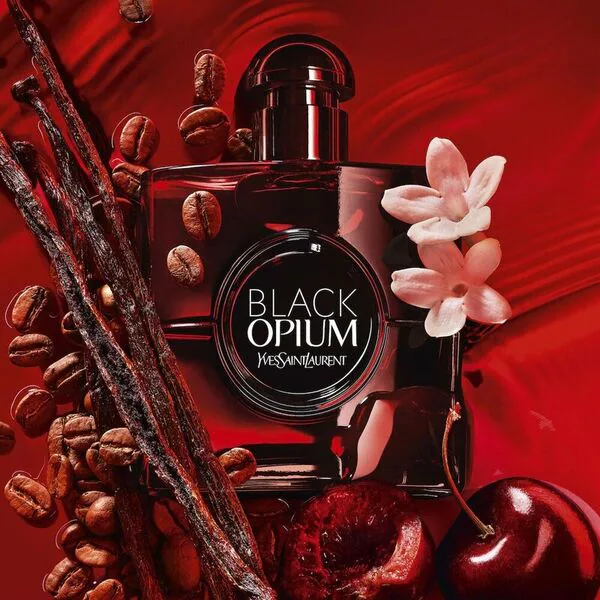
Parfum / Extrait de Parfum (20–30%+)
Overview:
The pinnacle of fragrance concentration, Parfum (also known as Extrait de Parfum or Pure Perfume) contains 20–30% or more perfume oils. These formulas represent perfume at its most luxurious and refined, often favored by collectors or as special occasion scents.
Longevity and Projection:
- Lasts 12–24 hours, sometimes noticeable on clothing days later.
- Projection is not necessarily nuclear—it tends to radiate gently from the skin, creating intimacy.
Use Cases:
- Romantic or formal occasions. Due to their richness, parfum formulas pair well with black-tie events or evenings.
- Cold climates. Dense compositions bloom beautifully in layers of winter air.
- Collectors & connoisseurs. The intense concentration allows subtle raw materials (like natural sandalwood, oud, or iris butter) to shine fully.
Style Notes:
Because of their strength, these aren’t meant for lavish spraying. Often one or two dabs suffice for an all-day impression. The fragrance’s development is slower and more nuanced, with heart and base notes lingering in greater focus than fleeting top notes.
Examples in the Market:
- Chanel No. 5 Parfum — The definitive standard of the extrait category.
- Dior J’Adore L’Or Parfum — An ultra-rich interpretation of Dior’s classic floral.
- Amouage attars — Rare Middle Eastern oils that showcase natural raw materials.
Special Cases and Cultural Variations
While the five categories above dominate Western perfumery, other forms and traditions are worth noting.
Perfume Oils and Roll-ons
These alcohol-free concentrates are common in niche, Middle Eastern, or indie brands. Applied directly to the skin, they often last 10+ hours and offer intimacy—warming with your body heat.
Attars
In Middle Eastern and South Asian cultures, traditional attars are distilled natural oils, ranging from rose to oud to saffron. Usually alcohol-free, they carry religious and cultural significance. Their richness far surpasses Western-style fragrances, and they can linger for days.
Body Mists / Aftershaves
At the opposite end of the scale, body mists and splashes (0.5–2% oils) are extremely light, often doubling as cooling sprays. Aftershaves incorporate antiseptic and soothing properties in addition to scent.
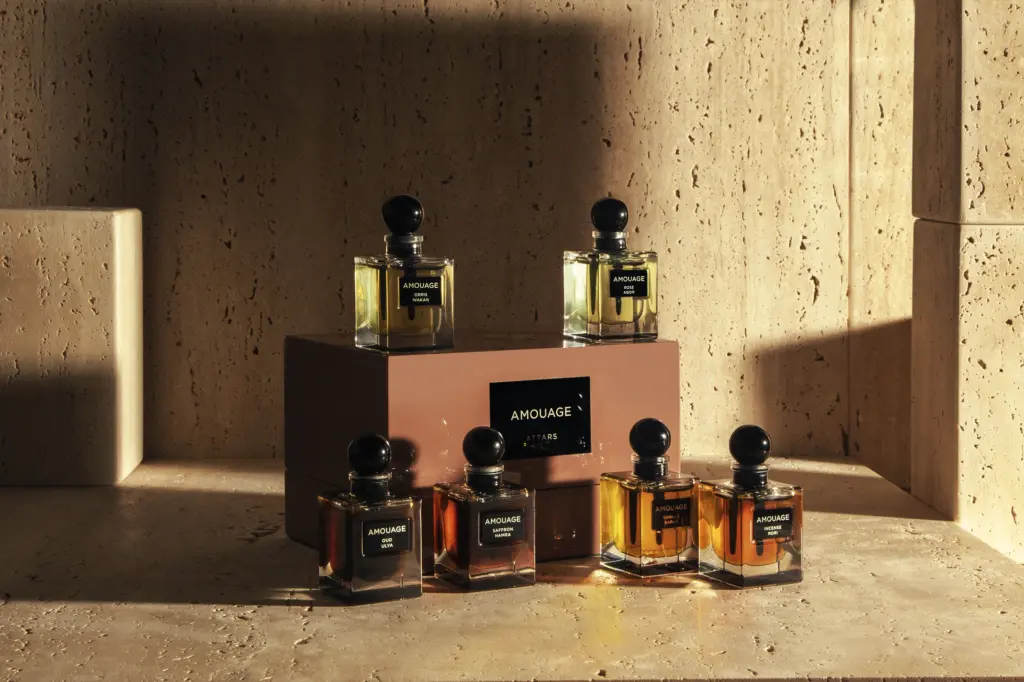
How Concentration Shapes the Experience
Now that we’ve explored the different fragrance categories, it’s time to dig into a more nuanced question: how does concentration actually shape the way you experience a perfume? Far from being a simple matter of “strong vs. weak,” fragrance concentration interacts with a variety of factors—including your skin, your environment, and even how you layer scents—to create a highly personal experience.
This is where art meets science. Two people could wear the exact same perfume, same concentration, same number of sprays, and yet smell completely different. Likewise, that same fragrance may project like a beacon in the summer, but feel muted in winter. Let’s break down the factors that determine why concentration impacts wear in such unique ways.
Longevity vs. Projection — Two Sides of the Same Coin
One of the most common misconceptions in fragrance is equating higher concentration with bolder scent. While concentration does impact performance, the relationship between longevity and projection is more complex than consumers often realize.
Longevity: This refers to how long a fragrance remains detectable on your skin (or clothing). Longevity depends not only on concentration but also on the volatility of the ingredients. Citrusy molecules, for example, are light and evaporate quickly no matter the concentration, while resins, woods, and musks stick around for hours.
Projection: This describes how far your fragrance diffuses into the air—whether it stays close to your skin or fills the room. Projection is not always improved by higher concentration. In fact, some very concentrated fragrances like Extrait de Parfum can feel more private, sitting almost like a “scent bubble” just around your body, since heavier oil concentrations evaporate more slowly and closer to the skin.
Why this matters:
- Eau de Toilette (EDT): Often feels louder, fresher, and more diffusive because of its lighter concentration. The alcohol base helps volatile top notes (like citrus, herbs, or spices) burst outward quickly. This gives EDTs a sparkling, energetic feel in the first few hours.
- Eau de Parfum (EDP) & Parfum: Tend to radiate more softly, with the scent unfolding more gradually. Think of this as the difference between shouting across a room (EDT) and whispering intimately into someone’s ear (Parfum).
This distinction is key: higher concentration = longer life on skin, but not necessarily greater reach in the air. Knowing what you prefer—diffusion that others notice immediately, or intimacy that lingers for hours—can help determine which concentration is right for you.
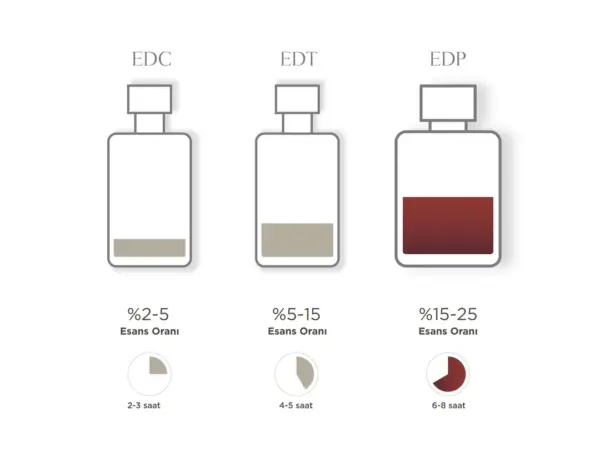
Skin Chemistry — The Personal Canvas of Scent
Perfume doesn’t just float above your skin; it interacts with it. And every person’s skin chemistry is unique, which means fragrance will never be a universal experience.
Oily Skin vs. Dry Skin
- Oily Skin: Natural oils act as fixatives, helping fragrance molecules bond and remain longer. People with oilier skin often notice fragrances last several hours longer.
- Dry Skin: Absorbs fragrance without holding it, causing evaporation to occur faster. Moisturizing prior to spraying—especially with an unscented lotion—can dramatically improve performance.
pH Balance and Body Heat
The pH levels of your skin can subtly shift how certain notes appear. For example, some people report that vanilla-heavy perfumes turn slightly sour on them, while others find amber notes smell warmer and sweeter. This isn’t the fragrance “turning bad”—it’s the natural chemistry of your skin influencing perception.
Similarly, people with naturally warmer body temperatures will notice fragrance diffuses more actively, sometimes boosting projection but shortening longevity. Cooler body temps may hold fragrance longer but closer to the skin.
How This Shapes Choice
If you find that fragrances fade too quickly on you, it may not be the fragrance’s fault. Instead of automatically upgrading from an EDT to an EDP, first try:
- Moisturizing your skin.
- Spraying on pulse points where blood flow keeps scent alive.
- Testing the same fragrance in different concentrations.
This kind of experimentation reveals what works best with your natural chemistry.
Climate Influence — Why Perfume is Seasonal
Another major factor in the fragrance experience is weather and climate. Perfume interacts with its environment as much as it does with your skin. Understanding how concentration behaves in different conditions can help you pick the right concentration for each season.
Hot Weather
Heat accelerates evaporation. This means fragrance notes lift off the skin more quickly. Citrus, aquatics, and greens thrive here because their light molecules project vibrantly in warmth—but even denser formulas can become overwhelming in hot climates.
- Best choice: Lighter concentrations like Eau Fraîche, Eau de Cologne, or Eau de Toilette.
- Why: They release quickly, feel refreshing, and don’t overwhelm. Think of a crisp lemonade versus a thick hot chocolate—your body naturally craves lightness in heat.
Cold Weather
In colder temperatures, molecules evaporate more slowly. This dampens projection and sillage (the scent trail), making lighter concentrations sometimes feel invisible.
- Best choice: Heavier formulas like Eau de Parfum or Parfum that can withstand slower evaporation.
- Why: Their richer, denser oils cling close to the skin and reveal themselves gradually, suiting cozy winter settings.
Humidity vs. Dryness
- Humid climates: Moisture in the air helps fragrance spread further, amplifying projection. A small spritz may carry farther than expected.
- Dry climates: Fragrance evaporates rapidly, requiring more frequent reapplication or denser concentrations.
Seasonal Example in Practice:
A citrusy cologne like Acqua di Parma Colonia feels airy and refreshing in summer but practically disappears in winter. Conversely, a resinous extrait like Chanel Coromandel Parfum feels glowing and luxurious in cold weather but suffocating if worn outdoors at 95°F.
This is why perfume enthusiasts often maintain “summer wardrobes” and “winter wardrobes” in their collection.

Layering by Concentration — Crafting a Unique Signature
One of the most overlooked aspects of fragrance is layering. Just as a chef layers flavors, fragrance lovers can build a personalized scent profile by combining different concentrations.
Why Layer?
- Extend longevity.
- Add depth or variety.
- Personalize a scent so it doesn’t smell exactly like everyone else’s.
How to Layer by Concentration
- Start with a Base Layer (Skin/Body Products):
Use a lightly scented shower gel, body cream, or even a matching lotion from the fragrance’s product line.
If these products carry the same signature notes, they act as anchors for your perfume.
- Add a Light Mist or EDT:
Apply an Eau Fraîche, body spray, or EDT as your “top” layer. This wakes up the senses with freshness while giving projection early in the day.
- Seal with a Dab of Extrait or Parfum:
Concentrated parfum provides staying power, clinging close to the skin. A small touch on pulse points ensures the fragrance stays present for hours after the EDT’s sparkle fades.
Result of Layering
- Longevity Boost: The base lotion helps oils bind to your skin, while the parfum ensures depth.
- Dimensional Scent: Instead of smelling linear, your fragrance evolves in stages. You get the brightness of an EDT upfront, followed by the richness of an extrait in later hours.
- Custom Signature: Even popular fragrances like Dior Sauvage or Chanel No. 5 can feel unique depending on how you layer them.
The Bigger Picture: Why This Matters
When you purchase a fragrance, knowing the bottle says EDT or Parfum only gives you part of the picture. The real effect depends on your skin, environment, and usage habits. This explains why some people complain that a fragrance “doesn’t last,” while on others it “lasts forever.” A fragrance’s journey isn’t static—it’s dynamic, affected by chemistry, weather, and lifestyle.
Understanding these interactions allows you to choose deliberately: the sparkling openness of a light EDT for summer mornings, the slow sensuality of a parfum for intimate evenings, or a layered combination when you want to stand out.
In short: concentration shapes the entire sensory story of a fragrance. It’s the difference between broadcasting freshness to a crowded room or whispering elegance only to those within arm’s reach.

Choosing the Right Concentration
Navigating the world of fragrances can feel overwhelming—luxurious bottles, evocative names, and the mystique of ingredients that sound more like poetry than chemistry. But perhaps the most personal aspect of finding your perfect scent is choosing the right concentration for your needs. This decision is not just about strength or how “expensive” a fragrance feels. It’s about matching your personality, lifestyle, daily routines, and even your sensitivities to the right olfactory experience. The ideal concentration for you is a delicate intersection of practicality, comfort, and self-expression.
Let’s walk through the major factors that should guide your choice:
By Occasion
Your daily activities and environments are critical to determining what level of fragrance concentration works best. Wearing the same powerful scent everywhere isn’t advisable, nor is sticking only to light formulas if you want your presence to linger at special moments.
Work/Daytime Settings:
For most office or professional environments, discretion is key. Overly intense or “loud” fragrances can intrude on colleagues’ personal space or even trigger sensitivities. Eau de Cologne or Eau de Toilette offer a subtle touch of freshness and warmth. They fade at a pace that suits regular work hours, allowing for a refresh before an after-hours event if needed. Citrus, green, or delicate floral EDTs are usually office-appropriate and universally pleasing.
Romantic Evenings and Special Occasions:
When the time comes to make a memorable impression—whether an intimate dinner, a wedding, or a night at the theater—Eau de Parfum or Parfum bring sophistication and allure. Their richness gradually unfolds, enveloping you in layers of scent that last through the evening. Think deep florals, spicy orientals, or comforting gourmands that warm with body heat and linger well into the night, leaving a lasting signature.
Travel, Sport, and On-the-Go:
For active days, gym sessions, or travel, lighter is better. Body mists, splashes, and light colognes can be reapplied liberally without fear of overwhelming those nearby. They freshen you up and provide a gentle clean sensation, perfect for times when you need subtlety rather than staying power.
By Lifestyle and Personality
Perfume is an extension of your character—how you want to be perceived, or even how you wish to feel.
The Extrovert’s Choice:
If you love being the center of attention and enjoy your fragrance making a statement, you’ll likely gravitate toward high-sillage and long-lasting formulas. Eau de Parfums with prominent projection or even certain Parfums suit social butterflies who enjoy bold introductions. These allow you to control the “volume” of your fragrance, letting your scent precede you into a room.
The Minimalist or Introvert:
If you prefer subtlety, minimalism, or simply reserve scent for personal enjoyment, Eau Fraîche, Eau de Cologne, or low-key EDTs fit best. These become your personal comfort zone, staying close to the skin and emerging only to those who are near. Fresh, “barely there” fragrances can also evoke a quietly confident, composed vibe—never demanding attention, but always present.
The Adventurer or Collector:
Some fragrance lovers build “wardrobes” for different moods, outfits, or experiences. They may have multiple concentrations of the same scent, using the lighter versions during the day and switching to heavier ones at night. For these enthusiasts, having a broad array of concentrations is part of embracing scent as a form of personal storytelling.
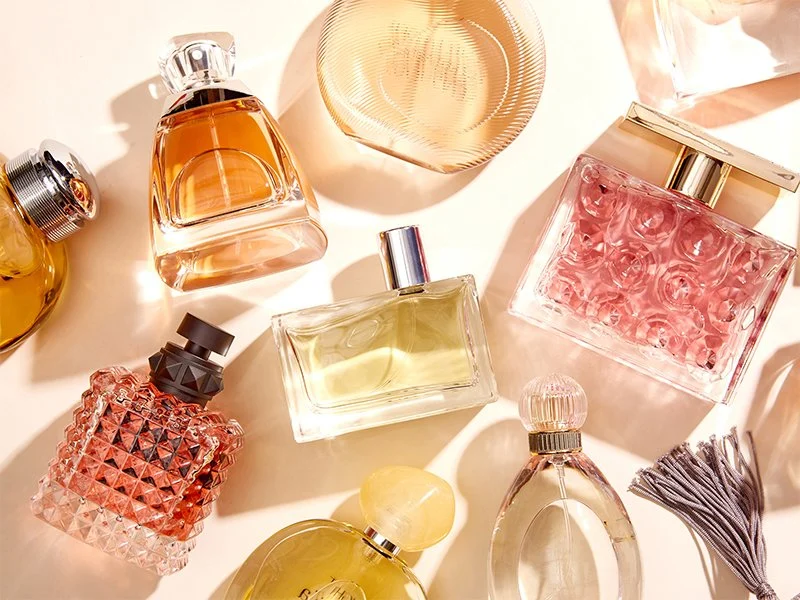
By Budget
While fragrance is a sensual pleasure, it’s also, quite bluntly, an investment. Concentration plays a major role in price:
Higher concentration = higher cost.
Extrait and Parfum forms use far more natural oils and rare ingredients—and they’re produced in smaller batches. The result is a luxury feel and remarkable longevity, but also a steep price tag.
Cost-effective alternatives.
EDTs and Colognes generally cost less and allow you to enjoy your favorite scents without as much upfront expenditure. They’re great for trying out a new fragrance style, for those who like to switch often, or for gifting.
Value in usage.
Bear in mind: while higher concentrations last longer and require fewer sprays, lighter concentrations can be applied more generously without concern, so a bottle may be used up faster. Decide whether you prefer longevity (less frequent repurchasing and fewer applications) or variety (switching up scents regularly).
By Sensitivity and Comfort
Not everyone can comfortably wear any fragrance, and some people have heightened sensitivities to certain aromas, solvents, or fixatives common in perfumes.
Allergies, Asthma, and Sensitive Skin:
If you have known sensitivities, opt for lighter concentrations like Eau Fraîche or Eau de Cologne, which have less perfume oil in the solution and lower risk of overwhelming reaction. Alcohol-free roll-ons or oils formulated for sensitive skin are also good choices. Fragrance-free lotions as a base can help buffer direct contact with perfumes.
Respecting Others:
In environments where scent sensitivity is common (public transportation, hospitals, or schools), use the lightest touch or forego heavy fragrances altogether. You can still enjoy scent—for instance, by applying a tiny amount to clothing or hair rather than directly on skin.
Personal Discomfort:
Some find that strong perfumes induce headaches, dizziness, or simply “feel too much.” If that’s you, stick to the lightest and freshest end of the spectrum, and always ask for sample vials before committing to a full bottle.
Myths & Misconceptions
For all the artistry and complexity behind fragrance creation, the world of perfume is crowded with myths and misunderstandings. These false beliefs can shape buying habits, limit exploration, and even prevent people from finding their perfect scent. Let’s dive into—and debunk—the three most persistent myths about fragrance concentration.
Myth 1: Higher Concentration Equals Stronger Smell
It’s easy to assume that a higher percentage of perfume oils in a bottle will result in an overwhelmingly powerful scent. The reality? Higher concentrations are often smoother, richer, and actually sit closer to the skin. Extrait or Parfum formulas unfold gradually, letting base and heart notes develop over hours without dominating the room.
Why does this happen? At higher concentrations, the composition favors deeper, heavier molecules that linger rather than burst outward. These perfumes are crafted for intimacy—the kind of scent you discover up close, not at a distance. Lighter concentrations, like Eau de Toilette or Cologne, often contain more alcohol, which helps lift brighter, more volatile notes into the air for greater projection. That’s why many EDTs feel fresh, “loud,” and diffusive—while Parfums can be experienced as soft, elegant, and long-lasting, but less immediately noticeable.
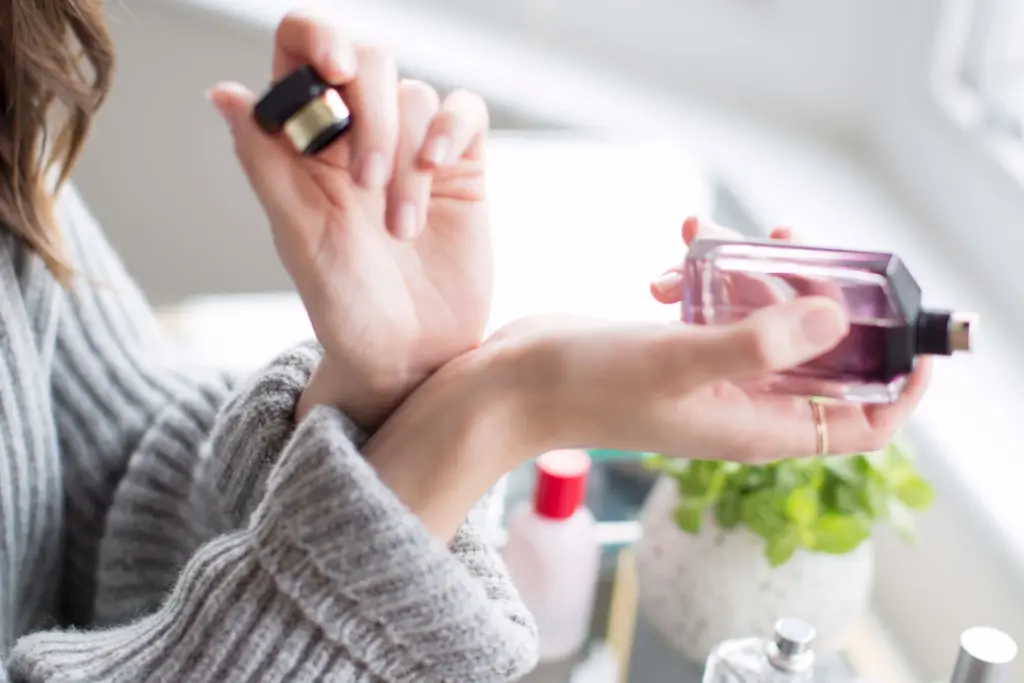
Myth 2: EDT Means Cheap, EDP Means Luxury
Another common misconception equates Eau de Toilette (EDT) with being a lesser, inferior, or “cheap” product—and Eau de Parfum (EDP) as the only marker of luxury or quality. This oversimplifies the purpose and beauty of both categories.
In truth, the distinction isn’t about value or prestige, but rather function and fragrance design. EDTs are formulated for lightness and refreshment, making them ideal for daytime wear, warmer climates, and occasions when subtlety is preferred. Many iconic scents started as EDTs due to their uplifting, sparkling character. EDPs are typically richer and longer-lasting, suited for evenings, cooler temperatures, and moments when you want your scent to endure.
Luxury is determined by the quality of ingredients, the skill of the perfumer, and the design of the blend, not by concentration alone. Some niche brands intentionally offer only EDTs to showcase bright or ethereal compositions, while designer houses often release multiple concentrations to suit different tastes and moments.
Myth 3: Longevity Equals Quality
It’s tempting to measure a perfume by how long it lasts on your skin—assuming that only enduring scents are worth your time or money. Perfume, however, is about experience, story, and emotion—not just endurance.
Some fragrances are artistically crafted to be fleeting, evoking memories, impressions, or moods that are gone almost as quickly as they arrive. For instance, a delicate Eau Fraîche or a summery Cologne might last only a few hours, but those hours can be bright, exhilarating, and joyful. By contrast, a resinous extrait can linger for a full day—not because it’s necessarily “better,” but because its notes are designed for lasting impact.
Quality comes down to how well the fragrance is balanced, how it develops, and whether it delivers the intended experience. Some of the world’s greatest perfumes are prized for their ephemeral beauty, not their staying power.
Conclusion
Fragrance concentration is only one element in the intricate tapestry that makes perfume such a powerful force in self-expression and sensory experience. While understanding the differences between Eau Fraîche, Eau de Cologne, Eau de Toilette, Eau de Parfum, and Extrait can radically improve the way you choose and wear scents, it’s essential to remember that these categories don’t operate in a vacuum. The ingredients, the environment you live in, and your own unique skin chemistry all contribute to how a fragrance unfolds upon you.
Choosing the right concentration isn’t a matter of ranking which is “best” or most luxurious—it’s about finding what truly fits your daily life, special occasions, and authentic self. For some, a brisk spritz of Eau de Toilette provides energy and subtle refinement for busy office hours. For others, the quiet intimacy and depth of an Extrait de Parfum becomes a kind of sensory armor or secret companion, appreciated solo or shared in close company. There are no wrong choices—only different forms of beauty waiting to be discovered.
